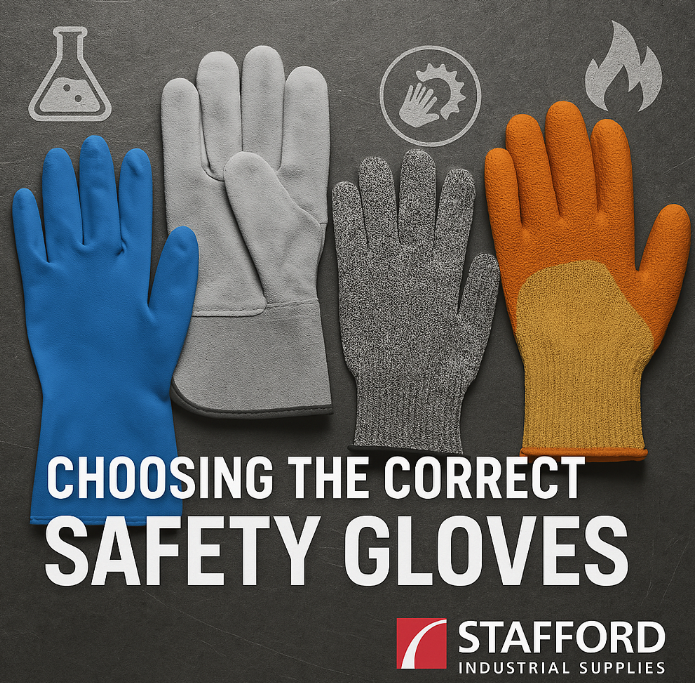When it comes to workplace safety, your hands are often on the front line. Whether you're handling chemicals, working with sharp tools, or exposed to extreme temperatures, choosing the right safety gloves is essential—not just for compliance, but for comfort and protection.
At Stafford Industrial Supplies, we understand that no two jobs are the same. That’s why we help you match the right glove to the right hazard. Here's how to make the best choice.
🔍 Step 1: Identify the Hazards
Before selecting gloves, assess the specific risks in your workplace. Common hazards include:
- Chemical exposure (e.g., solvents, acids)
- Mechanical risks (e.g., cuts, abrasions, punctures)
- Thermal hazards (e.g., heat, cold)
- Biological agents (e.g., bacteria, viruses)
- Wet work (e.g., prolonged exposure to water or detergents)
Each hazard requires a different type of glove material and design.
🧪 Step 2: Match the Glove to the Hazard
Here’s how to control each hazard with the correct glove:
1. Chemical Hazards
- Recommended Glove: Nitrile, neoprene, or PVC gloves
- Standard: EN374-3 (chemical protection)
- Why: These materials resist permeation and degradation from a wide range of chemicals. Always check the glove’s breakthrough time and permeation rate.
2. Mechanical Risks
- Recommended Glove: Cut-resistant gloves made from Kevlar®, Dyneema®, or steel mesh
- Standard: EN388 (mechanical protection)
- Why: These gloves protect against cuts, abrasions, and punctures, ideal for construction, metalwork, and handling sharp tools.
3. Thermal Hazards
- Recommended Glove: Heat-resistant gloves (e.g., leather, aluminised fabric) or insulated cold-weather gloves
- Standard: EN407 (heat) and EN511 (cold)
- Why: These gloves provide insulation and barrier protection against burns or frostbite.
4. Biological Hazards
- Recommended Glove: Disposable nitrile or latex gloves
- Standard: EN374-2 (microorganism protection)
- Why: These gloves offer a barrier against pathogens and are commonly used in healthcare and food handling.
5. Wet Work
- Recommended Glove: Waterproof gloves with EN374-2 certification
- Why: Prolonged exposure to water and detergents can cause dermatitis. Waterproof gloves help prevent skin irritation.
👷 Step 3: Consider the User and the Task
- Fit and Comfort: Gloves should fit snugly without restricting movement.
- Dexterity: For precision tasks, choose thinner gloves with tactile sensitivity.
- Duration of Use: For extended wear, prioritise breathable and ergonomic designs.
🛠️ Need Help Choosing?
Stafford Industrial Supplies is here to help you navigate glove selection. We offer:
- Expert advice tailored to your industry
- Access to glove performance charts
- A wide range of certified gloves for every application
📞 Call us on 01785 252744 or visit our contact page to speak with our team.
Stafford Industrial Supplies
Serving Industry Safety Since 1989
✅ Final Tip
Always review the product’s safety data sheet (SDS) and consult glove manufacturer charts to ensure compatibility with specific substances. No glove is universally resistant—the right glove makes all the difference.


